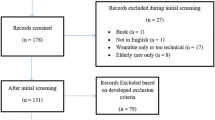Abstract
Cognitive deterioration in neurodegenerative diseases is progressive and leads to increasing need for the patient to be monitored and assisted. Unfortunately, mid-stage cognitive impaired patients may behave irrationally to attempt the integrity of their hosting environments or their own safety. This paper presents a new formal approach for the situation-awareness and the detection of abnormal behaviors of cognitive impaired people in situation-aware smart spaces. Instead of relying on the identification of deviations from normal behaviors, the approach is based on the specification and runtime verification of correctness properties. Situation Calculus is the formal method adopted to model the world; whereas, intelligent agents detect abnormal and dangerous situations. Dangerous situation recovery is also performed by ad-hoc intellignet agents.



Similar content being viewed by others
References
Cardelli L, Gordon AD (2000) Mobile ambients. Theor Comput Sci 240:177–213. doi:10.1016/S0304-3975(99)00231-5, http://portal.acm.org/citation.cfm?id=340593.340606
Coronato A, De Pietro G (2010) Formal design of ambient intelligence applications. Computer 43:60–68. doi:10.1109/MC.2010.335
Coronato A, De Pietro G (2010) Formal specification of wireless and pervasive healthcare applications. ACM Trans Embed Comput Syst 10(12):1–12:18. doi:10.1145/1814539.1814551
Coronato A, De Pietro G (2011) Tools for the rapid prototyping of provably correct ambient intelligence applications. IEEE Trans Softw Eng PP(99):1. doi:10.1109/TSE.2011.67
Coronato A, Gallo L (2012) Towards abnormal behavior detection of cognitive impaired people. In: PerCom Workshops, pp 859–864. IEEE
Lai K, Bo L, Ren X, Fox D (2011) A large-scale hierarchical multi-view rgb-d object dataset. In: IEEE international conference on robotics and automation, ICRA ’11. IEEE, Piscataway, NJ, USA
Liu CD, Chung YN, Chung PC (2010) An interaction-embedded hmm framework for human behavior understanding: with nursing environments as examples. Trans Info Tech Biomed 14:1236–1246. doi:10.1109/TITB.2010.2052061
Loy CC, Xiang T, Gong S (2009) Surveillance video behaviour profiling and anomaly detection. In: Society of Photo-Optical Instrumentation Engineers (SPIE) conference series. Presented at the Society of Photo-Optical Instrumentation Engineers (SPIE) conference, vol 7486. doi:10.1117/12.832188
McCarthy J (1963) Situations, actions, and causal laws. Technical Report Memo 2, Stanford Artificial Intelligence Project, Stanford University
Milner R (2008) Bigraphs and their algebra. Electr Notes Theor Comput Sci 209:5–19
Monekosso D, Remagnino P (2010) Behavior analysis for assisted living. IEEE Transactions on Automation Science and Engineering 7(4):879–886. doi:10.1109/TASE.2010.2049840
Mueller ET (2004) Event calculus reasoning through satisfiability. J Log Comput 14(5):703–730
Nater F, Grabner H, Van Gool L (2010) Exploiting simple hierarchies for unsupervised human behavior analysis. In: 2010 IEEE conference on Computer Vision and Pattern Recognition (CVPR), pp 2014–2021. doi:10.1109/CVPR.2010.5539877
Parry-Jones B, Parry-Jones WL (1992) Pica: symptom or eating disorder? A historical assessment. Br J Psychiatry 160(3):341–54. doi:10.1192/bjp.160.3.341, http://bjp.rcpsych.org/content/160/3/341.abstract
Reiter R (2001) Knowledge in action: logical foundations for specifying and implementing dynamical systems, illustrated edn. The MIT Press, Massachusetts, MA
Segal-Gidan F, Cherry D, Jones R, Williams B, Hewett L, Chodosh J (2011) Alzheimer’s disease management guideline: update 2008. Alzheimer’s and Dementia 7(3):e51–e59. doi:10.1016/j.jalz.2010.07.005, http://www.sciencedirect.com/science/article/pii/S1552526010024209
Xiang T, Gong S (2008) Video behavior profiling for anomaly detection. IEEE Trans Pattern Anal Mach Intell 30:893–908. doi:10.1109/TPAMI.2007.70731, http://portal.acm.org/citation.cfm?id=1399103.1399427
Xu X, Tang J, Liu X, Zhang X (2010) Human behavior understanding for video surveillance: recent advance. In: 2010 IEEE international conference on Systems Man and Cybernetics (SMC), pp 3867–3873. doi:10.1109/ICSMC.2010.5641773
Ye J, Dobson S, McKeever S (2011) Situation identification techniques in pervasive computing: a review. Pervasive and Mobile Computing (in press, corrected proof). doi:10.1016/j.pmcj.2011.01.004, http://www.sciencedirect.com/science/article/pii/S1574119211000253
Yin J, Meng Y (2009) Abnormal behavior recognition using self-adaptive hidden Markov models. In: Proceedings of the 6th international conference on image analysis and recognition, ICIAR ’09. Springer-Verlag, Berlin, Heidelberg, pp 337–346
Author information
Authors and Affiliations
Corresponding author
Rights and permissions
About this article
Cite this article
Coronato, A., De Pietro, G. Situation Awareness in Applications of Ambient Assisted Living for Cognitive Impaired People. Mobile Netw Appl 18, 444–453 (2013). https://doi.org/10.1007/s11036-012-0409-8
Published:
Issue Date:
DOI: https://doi.org/10.1007/s11036-012-0409-8




